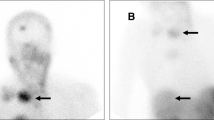Abstract
We report on a 70-year-old man affected by radioiodine-refractory differentiated thyroid cancer (DTC) in whom metastases were treated by peptide receptor radionuclide therapy (PRRT). Seven years before, patient had undergone total thyroidectomy. Pathological examination was conclusive for DTC. The patient underwent some radioiodine treatments (RaIT). The last post-therapy whole body scan (pT-WBS) performed five days after RaIT did not show abnormal radioiodine uptake but serum thyroglobulin (Tg) value was high in absence of thyroglobulin-antibodies (Tg-Ab). In-111 DTPA-pentetreotide scintigraphy showed several lung lesions with high somatostatin receptor density. Patient underwent PRRT using Lu-177 DOTATOC. pT-WBS scan confirmed the metastases already demonstrated by In-111 DTPA pentetreotide but radioiodine negative.

Similar content being viewed by others
References
H. Budiawan, A. Salavati, H.R. Kulkarni, R.P. Baum, Peptide receptor radionuclide therapy of treatment-refractory metastatic thyroid cancer using (90)Yttrium and (177)Lutetium labeled somatostatin analogs: toxicity, response and survival analysis. Am. J. Nucl. Med. Mol. Imaging 4(1), 39–52 (2013)
B. Jois, R. Asopa, S. Basu, Somatostatin receptor imaging in non-(131)I-avid metastatic differentiated thyroid carcinoma for determining the feasibility of peptide receptor radionuclide therapy with 177Lu-DOTATATE: low fraction of patients suitable for peptide receptor radionuclide therapy and evidence of Chromogranin A level-positive neuroendocrine differentiation. Clin. Nucl. Med. 39(6), 505–510 (2014)
D.J. Kwekkeboom, E.P. Krenning, R. Lebtahi, P. Komminoth, B. Kos-Kudla, W.W. de Herder, U. Plockinger, Mallorca Consensus Conference participants, European Neuroendocrine Tumor Society, ENETS Consensus Guidelines for the standards of care in neuroendocrine tumors: peptide receptor radionuclide therapy with radiolabeled somatostatin analogs. Neuroendocrinology 90(2), 220–226 (2009)
Conflict of interest
The authors disclose no conflict of interest and no founding received for this work.
Author information
Authors and Affiliations
Corresponding author
Rights and permissions
About this article
Cite this article
Campennì, A., Pignata, S.A. & Baldari, S. Can peptide receptor radionuclide therapy (PRRT) be useful in radioiodine-refractory differentiated thyroid cancer?. Endocrine 50, 516–518 (2015). https://doi.org/10.1007/s12020-014-0491-8
Received:
Accepted:
Published:
Issue Date:
DOI: https://doi.org/10.1007/s12020-014-0491-8




